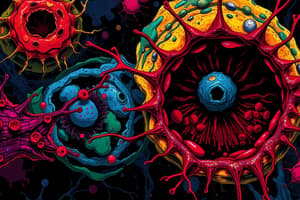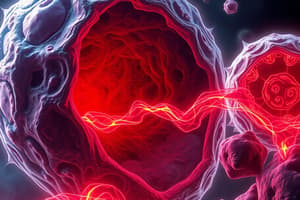Podcast
Questions and Answers
Apoptosis leads to cell shrinkage and increased density of cytoplasm.
Apoptosis leads to cell shrinkage and increased density of cytoplasm.
True (A)
Tumors are resistant to apoptosis during their active growth phase.
Tumors are resistant to apoptosis during their active growth phase.
False (B)
ER stress is the basis of degenerative diseases in the cardiovascular system.
ER stress is the basis of degenerative diseases in the cardiovascular system.
False (B)
Viral infections like HIV and Hepatitis can lead to cell death through apoptosis.
Viral infections like HIV and Hepatitis can lead to cell death through apoptosis.
Apoptotic bodies are usually phagocytosed by neutrophils.
Apoptotic bodies are usually phagocytosed by neutrophils.
Radiation and cytotoxic drugs can cause DNA damage leading to apoptosis.
Radiation and cytotoxic drugs can cause DNA damage leading to apoptosis.
Apoptosis is a pathway of cell death that is induced by a tightly regulated suicide program.
Apoptosis is a pathway of cell death that is induced by a tightly regulated suicide program.
Necrosis and apoptosis have similar features.
Necrosis and apoptosis have similar features.
Apoptotic cells always elicit an inflammatory reaction.
Apoptotic cells always elicit an inflammatory reaction.
Apoptosis occurs only in pathologic conditions.
Apoptosis occurs only in pathologic conditions.
Hormone-dependent involution is an example of a physiologic cause of apoptosis.
Hormone-dependent involution is an example of a physiologic cause of apoptosis.
Apoptosis is a random process that occurs without any regulation.
Apoptosis is a random process that occurs without any regulation.
Necrosis is characterized by reduced cell size and intact plasma membrane.
Necrosis is characterized by reduced cell size and intact plasma membrane.
In apoptosis, cellular contents undergo enzymatic digestion and may leak out of the cell.
In apoptosis, cellular contents undergo enzymatic digestion and may leak out of the cell.
Apoptosis involves a reduction in cell size, brightly eosinophilic cytoplasm, and a condensed nucleus.
Apoptosis involves a reduction in cell size, brightly eosinophilic cytoplasm, and a condensed nucleus.
Necrosis is invariably a physiologic process.
Necrosis is invariably a physiologic process.
Protein cleavage in apoptosis is carried out by protease 'caspases'.
Protein cleavage in apoptosis is carried out by protease 'caspases'.
Apoptosis is a means of eliminating unwanted cells.
Apoptosis is a means of eliminating unwanted cells.
Apoptotic bodies are formed when cytoplasmic proteins swell and expand.
Apoptotic bodies are formed when cytoplasmic proteins swell and expand.
Signals from plasma membrane receptors in the death receptor pathway lead to the activation of executioner caspases.
Signals from plasma membrane receptors in the death receptor pathway lead to the activation of executioner caspases.
Apoptosis is also known as necrosis.
Apoptosis is also known as necrosis.
DNA breakdown in apoptosis is mainly mediated by exo-nucleases.
DNA breakdown in apoptosis is mainly mediated by exo-nucleases.
The two main pathways of apoptosis are the Death receptor Pathway and the Endoplasmic Reticulum Pathway.
The two main pathways of apoptosis are the Death receptor Pathway and the Endoplasmic Reticulum Pathway.
Imbalance in the BCL2 family of proteins can lead to leakage of pro-apoptotic substances from the nucleus.
Imbalance in the BCL2 family of proteins can lead to leakage of pro-apoptotic substances from the nucleus.
Flashcards are hidden until you start studying




